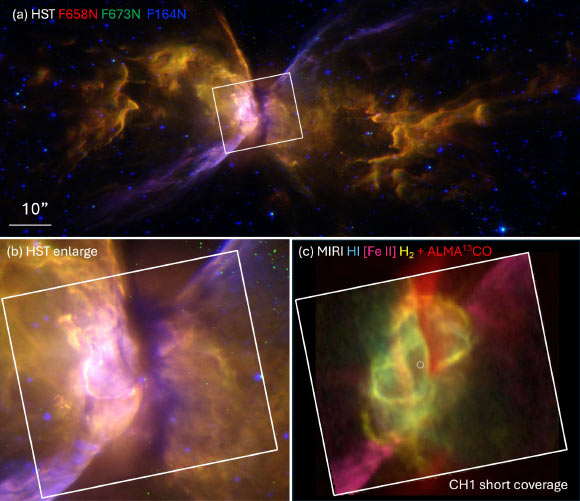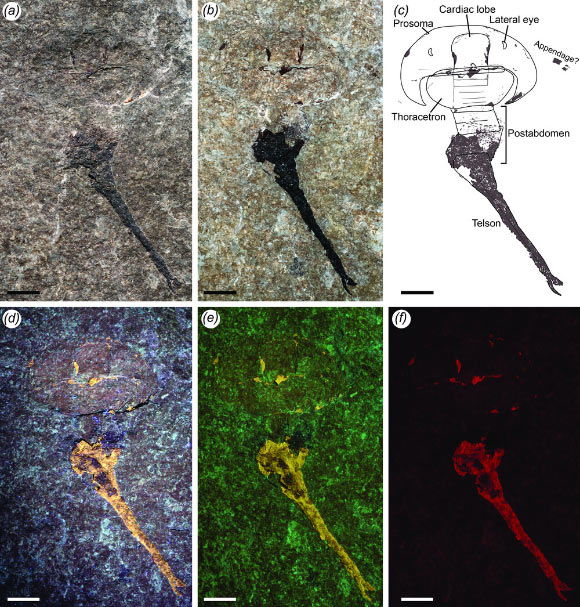With the help of the NASA/ESA/CSA James Webb Space Telescope, astronomers have made a big leap forward in the understanding of how the raw material of rocky planets comes together. This cosmic material — crystalline silicate dust and polycyclic aromatic hydrocarbons was studied at the core of a spectacular bipolar planetary nebula called the Butterfly Nebula.
Hubble and Webb/ALMA images of the Butterfly Nebula. Image credit: NASA / ESA / CSA / Webb / Hubble / ALMA / Matsuura et al., doi: 10.1093/mnras/staf1194.
The Butterfly Nebula, otherwise known as NGC 6302, is among the best-studied planetary nebulae.
This nebula is located approximately 2,417 light-years away from Earth in the constellation of Scorpius.
Its butterfly shape stretches for more than two light-years, which is about half the distance from the Sun to Proxima Centauri.
The object shows extreme bipolar, complex morphology, the presence of very high excitation gas, high molecular mass, and crystalline silicate dust.
“Planetary nebulae are among the most beautiful and most elusive creatures in the cosmic zoo,” said Cardiff University astronomer Mikako Matsuura and colleagues.
“These nebulae form when stars with masses between about 0.8 and 8 times the mass of the Sun shed most of their mass at the end of their lives.”
“The planetary nebula phase is fleeting, lasting only about 20,000 years.”
“Contrary to the name, planetary nebulae have nothing to do with planets: the naming confusion began several hundred years ago, when astronomers reported that these nebulae appeared round, like planets.”
“The name stuck, even though many planetary nebulae aren’t round at all — and the Butterfly Nebula is a prime example of the fantastic shapes that these nebulae can take.”
“The Butterfly Nebula is a bipolar nebula, meaning that it has two lobes that spread in opposite directions, forming the ‘wings’ of the butterfly,” they added.
“A dark band of dusty gas poses as the butterfly’s ‘body’. This band is actually a doughnut-shaped torus that we see from the side, hiding the nebula’s central star — the ancient core of a Sun-like star that energizes the nebula and causes it to glow.”
“The dusty doughnut may be responsible for the nebula’s insectoid shape by preventing gas from flowing outward from the star equally in all directions.”
The new image from Webb’s Mid-InfraRed Instrument (MIRI) zooms in on the center of the Butterfly Nebula and its dusty torus, providing an unprecedented view of its complex structure.
The astronomers identified nearly 200 spectral lines, each of which holds information about the atoms and molecules in the nebula.
These lines reveal nested and interconnected structures traced by different chemical species.
The researchers also pinpointed the location of the Butterfly Nebula’s central star, which heats a previously undetected dust cloud around it, making the latter shine brightly at the mid-infrared wavelengths that MIRI is sensitive to.
With a temperature of 220,000 Kelvin, this is one of the hottest known central stars in a planetary nebula in our Galaxy.
This image takes the viewer on a deep dive into the heart of the Butterfly Nebula, as seen by Webb. Image credit: NASA / ESA / CSA / Webb / M. Matsuura / ALMA / ESO / NAOJ / NRAO / N. Hirano / M. Zamani.
“This blazing stellar engine is responsible for the nebula’s gorgeous glow, but its full power may be channeled by the dense band of dusty gas that surrounds it: the torus,” the authors said.
“The new Webb data show that the torus is composed of crystalline silicates like quartz as well as irregularly shaped dust grains.”
“The dust grains have sizes on the order of a millionth of a meter — large, as far as cosmic dust is considered — indicating that they have been growing for a long time.”
“Outside the torus, the emission from different atoms and molecules takes on a multilayered structure.”
“The ions that require the largest amount of energy to form are concentrated close to the center, while those that require less energy are found farther from the central star.”
“Iron and nickel are particularly interesting, tracing a pair of jets that blast outward from the star in opposite directions.”
Intriguingly, the team also spotted light emitted by carbon-based molecules known as polycyclic aromatic hydrocarbons (PAHs).
“They form flat, ring-like structures, much like the honeycomb shapes found in beehives,” the astronomers said.
“On Earth, we often find PAHs in smoke from campfires, car exhaust, or burnt toast.”
“Given the location of the PAHs, we suspect that these molecules form when a ‘bubble’ of wind from the central star bursts into the gas that surrounds it.”
“This may be the first-ever evidence of PAHs forming in an oxygen-rich planetary nebula, providing an important glimpse into the details of how these molecules form.”
The findings were published this week in the Monthly Notices of the Royal Astronomical Society.
_____
Mikako Matsuura et al. 2025. The JWST/MIRI view of the planetary nebula NGC 6302 – I. A UV-irradiated torus and a hot bubble triggering PAH formation. MNRAS 542 (2): 1287-1307; doi: 10.1093/mnras/staf1194































